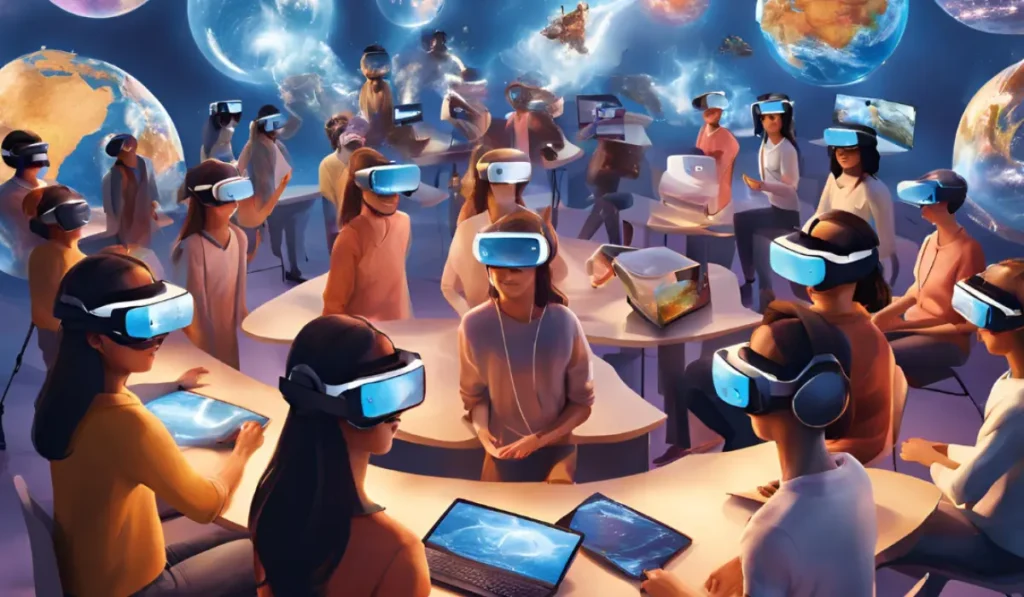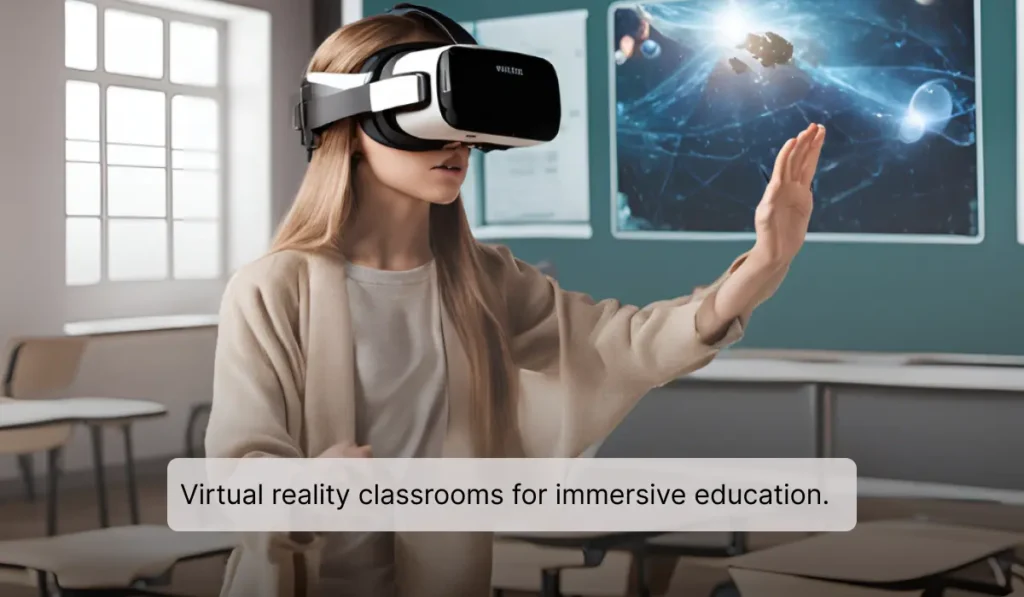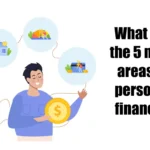Educators need to know what the virtual reality is and its importance in education.
VR is not just limited to gaming or entertainment anymore. Now it’s come to the education field, providing an interactive and immersive experience. VR it is a device that allows you to immerse yourself in a simulated environment, where you can interact with the things around you as if they were real. In education, this means experiential — that is, students can better experience content in a three-dimensional environment.
Classrooms have come a long way since many years. Technology has been embraced by learning communities from traditional blackboards to smartboards, to virtual environments, and used as a tool to make learning more effective and more accessible. VR is the next step in this evolution, with the potential to revolutionise the delivery and consumption of knowledge.
Examples of Virtual Reality in Classrooms
Simply put, the uses for VR in the classroom are virtually limitless and span any number of topics and disciplines. For instance:
What is VR role in educationSTEAM: VR enables students to visualize abstract concepts, for example walking through the human circulatory system which can be translated to STEAM subjects like science and math, virtual reality applications, for example leveraging VR knowledge sharing in classrooms and facilitating interactive VR class simulations in a 360-degree environment.
History and Geography — Virtual field trips can allow students to explore historical landmarks, ancient civilizations, or even outer space without ever leaving their classroom.
Arts and Design: Aspiring artists can also create and interact with three-dimensional models, and designers can simulate architectural designs.
Here are some real life use cases of VR in classrooms:
Virtual Field Trips: Sites like Google Expeditions take students on virtual tours to places like the Great Wall of China or the surface of Mars.
Lab Simulations: Some tools like Labster provide risk-free environments for students to perform experiments that may be too unsafe or expensive to do in real life.
Interactive Learning: Students can immerse themselves deeply in subjects by visiting virtual environments, making real-life connections, and exploring areas in 3D that would otherwise be impossible to visit.
Advantages of Virtual Reality Classrooms
VR in the Classroom – Advantages of Supporting VR in Classrooms:
Better Engagement and Retention: Immersive learning holds students’ attention more than traditional methods, resulting in increased retention of concepts.
Access to Experiences (without traveling): VR allows experiences that might be impossible because of physical, geographical, or financial barriers.
Protected and Controlled Environments: Students can practice activities that might be dangerous in the real world — flying a plane, for example, or performing an operation — without worrying that they will hurt anyone.
VR is also promoting collaboration and inclusivity among students from different cultures by virtually introducing them to each other and letting them learn together.
But What’s It like an Immersive experience?
VR immersion is the user’s sense of being present in a virtual environment. This sense of being there is done by:
Interactive Experience: VR engages players more than regular video games.
Interactive elements promote cognitive engagement, which helps to make the learning process more effective.
These are some examples of immersive educational tools:
VR Simulations: Students feel history or science as they lived.
Interactive Games: VR educational games provides learning fun and competitive.
VR in Education: Who is using it?
The following are some of the schools, universities who have taken a leap to use VR in education. Case studies include:
Stanford University: Leveraging its VR Lab, Stanford employs VR to teach subjects such as environmental science and empathy-building.
Google Expeditions — this tool has allowed thousands of classrooms to take virtual tours of world wonders and natural phenomena.
Labster: Labster’s VR labs are used in schools across the globe and have revolutionized the way science experiments are done.
Example of these success stories are improved outputs of students in the form of better engagement and understanding of more complex topics. Teacher testimonials highlight the simplicity of integrating VR into current curricula.
Differences Between Traditional and Virtual Classrooms
There are many differences found on comparing the traditional with a virtual classroom:
| Aspect | Traditional Classrooms | Virtual Classrooms |
|---|---|---|
| Teaching Methods | Lecture-based | Interactive and immersive |
| Tools | Books, whiteboards | VR headsets, simulations |
| Accessibility | Limited to physical location | Global and inclusive |
| Learning Outcomes | Passive learning | Active engagement and retention |
A lot of benefits can be gained from using VR classrooms, however, it is important not to lose sight of the human factor in education. Teachers are still critical in how students navigate this and making sure the technology is used well.
The Effectiveness of Virtual Classes
Research indicates that VR achieves this by improving learning outcomes for students because learning is more interactive and engaging. Research on the comparative effectiveness of virtual classes and traditional methods shows that wherever possible, students tend to retain information better when exposed to immersive experiences. But the success of VR is dependent on a number of things:

Educational Content: Well-designed VR content should adapt to educational purposes and provide deeper understanding.
How often are VR tools used: Regular utilization can increase students’ familiarity with technology (thus improving both) experience.
Teacher Training: The success of VR in education relies on proper training of educators to incorporate this technology into their curricula.
The Best VR for Education: A Comprehensive Selection Guide
Since features, affordability, and use cases influence your choice of VR platform, there are many options available which may suit you. Here’s a rundown of some leading platforms:
Oculus Rift: Where Good Graphics, Good Interactive Game Mechanics Simulations Are Complex Simulation
HTC Vive — Impressive motion tracking and wide selection of educational apps.
Google Cardboard Virtual reality headsets can be a relatively affordable option for classrooms and are well-suited for virtual field trips and basic VR experiences.
This is Microsoft HoloLens it has both VR and AR capability so it is capable of immersive learning as well as real-world application.
How to set up a Virtual Reality classroom
There are several steps to implementing a VR classroom:
Choosing the Right Hardware and Software: Identify devices/platform that will fit your educational goals and budget.
Align VR content with existing lesson plans for seamless integration.
Strategy 2: Training Teachers and Students
Custom Virtual Environment Building: Create environments customized to specific subjects and learning objectives.
Disadvantages and limitations of VR in education
But VR faces a number of challenges despite its advantages:
Challenges: VR can be costly to implement and acquire.
Health Concerns: Extended use can lead to symptoms of motion sickness or eye strain.
Technical Challenges: Many teachers have a steep learning curve to overcome when embracing VR tools.
Limited Socialization: Excessive reliance on VR might impair real-life social skills.
Use of VR in Various Domains of Education
VR is revolutionizing education in a range of fields:
STEM: Interactive coding tutorials and simulations make STEM subjects engaging.
Medicine: Surgery; studying anatomy; gives students risk free hands-on practice.
Arts and Humanities: Virtual tours and historical re-creations can animate subjects.
Vocational: Students can gain hands-on experience, such as automotive repair and practice hospitality with VR.
Changing the Game: The Effects of Virtual Reality on Education
VR revolutionizes the educational experience by making the gap between theory and practice closer than ever. It also offers students hands-on, experiential learning experiences, preparing them to succeed in tech-driven futures. By acting on various senses, VR creates a stronger sense of reality leading to a more comprehensive and long-term understanding.
Virtual Reality Classrooms: The Future of Learning
VR Trends to Watch for 2025 AI-powered VR, AR-VR integration, and personalized learning platforms. Experts see widespread adoption as costs go down and the technology improves. Hybrid models that combine VR with traditional methods may provide the best of both worlds.
Ethical and Social Implications
To avoid exacerbating the digital divide, we must ensure equitable access to VR technology. Privacy and data security issues will be a challenge and educators should balance screen time with offline learning for holistic development.
Conclusion and Call to Action
Virtual Reality: Redefining learning by providing multiple progressive learning experiences Integrating VR into classrooms can help institutions break geographical and physical barriers, promote global collaboration, and help students to prepare for the tech-driven world of tomorrow.
More specifically, educators and policymakers should be proactive in researching and investing in VR as an educational tool. Immersive learning is a road we must travel — one paved with innovation and equity. With you, we forge a limitless future of learning.
Bonus Sections
FAQ Section
How much does VR in the classroom cost?
The costs differ depending on the hardware, software and content needed. Google Cardboard costs just a few dollars; other systems, such as the Oculus Rift or the HTC Vive, cost hundreds.
Is virtual reality is hard for teachers?
There can be a learning curve and many platforms offer training resources, as well as user-friendly interfaces, to assist educators in getting up to speed.
How about maintenance and updates?
It does require routine software updates and hardware maintenance, but most providers will offer support.
Resources for Educators
Some of the platforms: Google Expeditions, Labster and Nearpod.
Courses: You can find some VR training on platforms like coursera and udemy
Tools: Cost-effective VR headsets, including Oculus Quest 2, and teacher guides.
Tips for Parents and Students
PRAM: PRAM is a parent group for tech-focused adults that encourages child VR assistance and monitors screen time.
Students: Look into VR tools that can supplement traditional learning, while also engaging with interactive content in a responsible manner.









2 thoughts on “Virtual Reality Classrooms: Transforming Immersive Education in 2025”